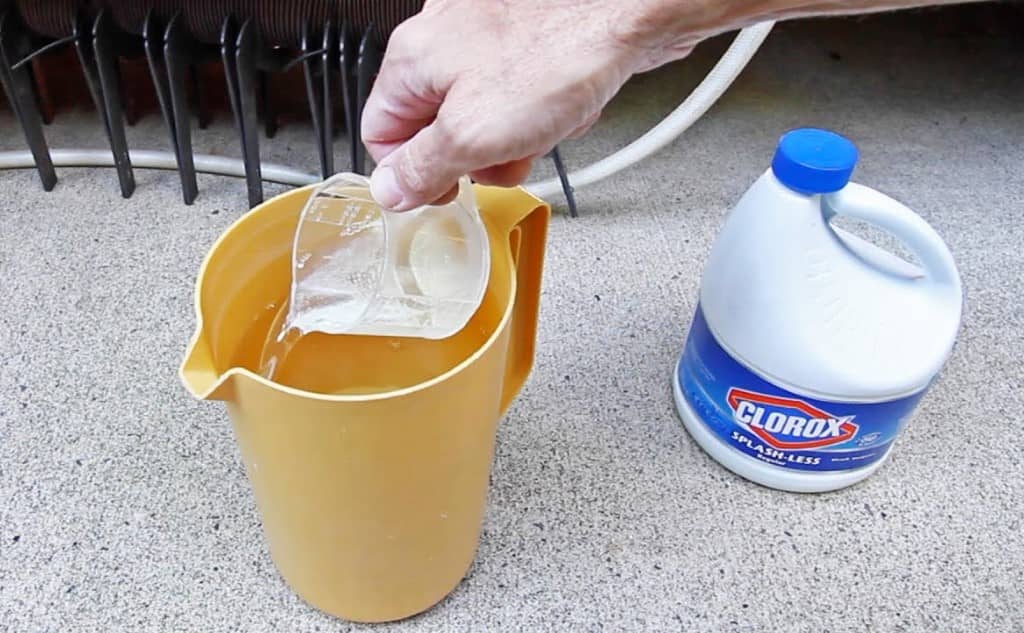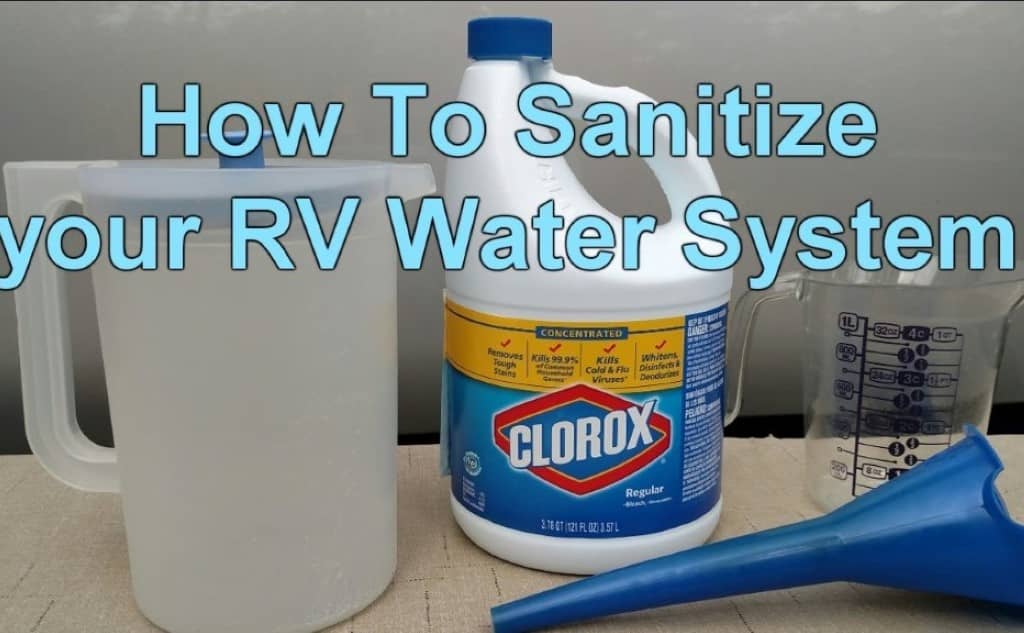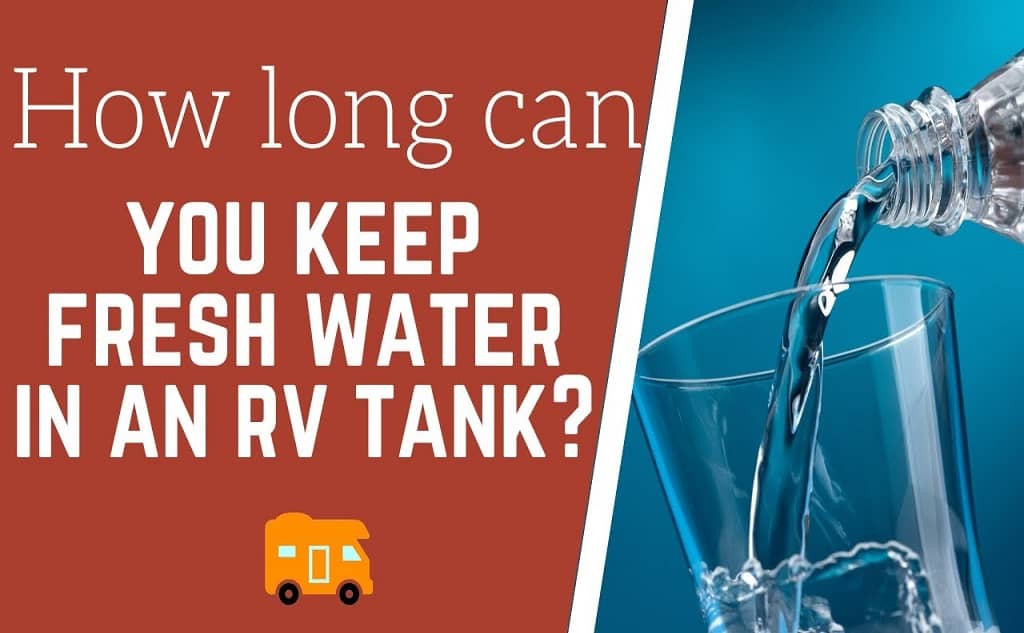When you buy through links on our site, we may earn an affiliate commission, Read More.
Planning a long trip in the woods or countryside? Curious about how long to keep fresh water in the RV tank for safe use? Yes. It’s hard to find a clean water source in the campground. But let me set your mind at ease today.
You can safely use water from your RV fresh water tank for up to Two weeks. After that those waters are only good for washing and bathing. Other issues can compromise tank integrity and are easy to forget. Want to know what they are?
Let’s get started.
How Long To Keep Fresh Water In RV Tank For Safe Drinking?

If you are going on a long trip, you might want to know how long you keep the water for safe drinking. In general, it depends on a lot of factors like the quality of water, heat, and cleanliness of your tank. But the rule of thumb is not more than two weeks.
Drinking water is one of the most important resources in your Motorhome. While traveling remote places, your freshwater tank will be your great source of drinkable water assuming you have a clean tank.
You could always buy drinking water from the store but you have a large tank in your RV. With that tank, you could store more water for a drink and other use. Some travelers also use a potable water tank for their RV. These are around 5-10 gallons each and serve the cause perfectly.
Some problems of filling the fresh water tank on RV are quality degradation, discoloration, and off-putting taste. The easy way to tackle these issues is with Chlorine tablets and additives. These keep your water clean and drinkable for a longer time.
Another way you can prolong your water storing is by installing a water filter. You can either install it on the intake or in the output line. If you want extra filtering you can install it on both sides.
Why You Shouldn’t Store Water For A Long Time In An Rv?

Leaving water in the RV tank for too long is never a good idea. Even if you have top-quality water; the presence of high temperature, tank material, and the anaerobic environment can cause bacteria to grow rapidly. Not to mention, the risk of developing algae and mold.
A common concern among the new RV owners is whether they should keep or discard the same water that’s been in the tank for weeks. If you are using that for just washing, you can store it longer but drinking can be dangerous and you should not do that either.
Your RV water storage is usually a plastic tank. That Plastic when comes in contact with high temperatures reacts with water. You think your water is clean but at times it will go bad no matter how hard you maintain the water reservoir.
So, why take the risk?
You could always replace the water within minutes. Just start your trip with a fresh tank of water and discard the remaining at the end of your trip. It’s not always an easy task to keep tabs on the water so better take the safe path than be sorry later.
Can You Drink Water from RV Freshwater Tanks?
In short, you can drink water from an RV freshwater Tank as long as the water is from a clean source. That’s not all, you also have to be sure that you have carried out necessary sanitization for the tank. So, the water stays fresh for the time being.
On another note, a tight seal on the tank also helps to keep the integrity of water by not allowing any foreign substance in the tank. Even though you managed all these your water may still go bad after a certain period.
That’s why many travelers still prefer boiling the water or carrying water gallons for drinking purposes. It’s an easy way to avoid health risks and deal with extensive decontamination of your water reservoir.
So, despite it’s a safe way to store drinking water, the risk will still be there. It’s up to you whether you want to solely depend on your freshwater tank or bring an extra water bottle.
Can You Use Older Freshwater For Bathing and Washing?

As I mentioned earlier, two weeks is the max limit to use a freshwater tank for drinking. But it doesn’t mean you can’t use the old water for other works. The water is still usable to wash anything or take a bath as long it’s not showing any discoloration or funky smell.
As the water gets older some natural phenomena like mold, algae, or microbial infestation starts to show up. Most of these are not that harmful at their initial establishment, but once they grow large it will become a problem.
Many microorganisms are in the air floating in a dormant state. It’s not that hard for them to get into your tank and start reproducing. Once they find a secure water source perfect for their need, they become active to replicate themselves.
So yes! You can still use old water for flushing your toilet, washing your hands, and even for a bath. But don’t take this for granted after two weeks. Look for the signs and inspect tank conditions every week for mold and algae build-up.
How Can You Maintain A Clean Tank To Keep RV Water Fresh?

Most RV tanks you see on the market or in any motorhome usually have a plastic body. The problem with the plastic body is they do not cope well with heat and breeding ground for many microorganisms. That’s why it would be in your best interest to know about RV freshwater tank maintenance as much as possible.
Here are some tips to maintain a healthy freshwater tank.
1. Get a Quality Freshwater tank
Plastic is not a great material for freshwater storage unless it’s a high-grade plastic. In the making of freshwater tanks, recycling old plastic is a pretty common procedure. It’s ok to use such a tank in most cases but when it comes to drinking you should get one with the high-grade plastic.
Low-quality plastic often adds a plasticky smell to the water. On top of that, high temperatures also react with the plastic and often release toxic elements to the water. Even if you are not using that for drinking, the result won’t be comfortable for other use cases as well.
2. Refill your freshwater tank every two week
If you are on a long trip it’s not always possible to fill your RV tank frequently. However, it’s a simple way to maintain tank health by not letting bacteria grow. Every time you dump the old water, the most harmful element goes along with it.
3. Try to store clean/quality water
Water quality also plays a big role in maintaining a freshwater holding tank for RV. If your water source already has contaminants in it, how well do you think it will perform in your tank? With little help from heat it could get worse in the anaerobic atmosphere.
4. Use proper filling equipment
Filling equipment like hoses, nozzles, and valves are important in delivering cleaner water to your tank. Keep them clean and use them only for filling out the fresh water tank. Dirt, gunk, and rust can easily find their way into this equipment.
Apart from these, sanitizing your tank in proper intervals is another great way to maintain tank health. I will discuss how to sanitize an RV water tank in a later section with a step-by-step guide.
Common RV Water Tank Size
RV trailers come with a variety of tank sizes to fulfill a range of water needs on a daily basis. If you are familiar with RV tanks you will see tank size between 30 to 52-gallon capacities. Of course, you can always go higher depending on the space available in your RV.
Each Tank size has an effective usage perimeter to serve you from 5 to 8 days. That leaves you with about 6-gallon water per day. If you reduce your usage it will extend the perimeter.
Here is a table for some popular RV model and their tank size.
RV Model | Tank Size |
Dutchmen Aspen Trail | 27 gal |
Jayco Jay Flight | 42 gal |
Keystone Bullet | 43 gal |
Winnebago Minnie | 31 gal |
Winnebago Micro Minnie | 31 gal |
About Algae Problem In Rv Water Tanks
Ever wonder what are the green patches floating on ponds or lakes? That’s algae, a cluster of marine microorganisms that are capable of photosynthesis, hence the green outlook. As I said it conducts photosynthesis, it needs sunlight. But some variations also reproduce under heat.
Algae are common RV hot water tank problems. Leaving water in the tank for too long and heat from the atmosphere causes these microbes to flourish. Most of the time you won’t notice until it’s too late and you smell/taste the funkiness.
Eliminating Algae In The Freshwater Tank

The thing is no matter which RV model you have Algae will grow once it finds a suitable environment. To eliminate this you need proper maintenance and sanitization of the tank on a regular basis.
Here are a few quick pointers for you to follow
1. Bleach
Bleach is a common cleaning solution for its powerful properties. From microbes to large molds it can clean almost anything. The same thing is true for algae cleaning. Give a good wash with bleach-water and then rinse with plain water for effective results.
2. Vinegar
Sanitize RV water tank with vinegar. The good thing with vinegar is you can find vinegar in most households without even going to the shop. Mix a cup of vinegar in a gallon of water and give a good rinse inside the tank. Then rinse with plain water to drain the residues.
3. Chlorine Solution
Chlorine solution comes in tablets, powder, and liquid form. Use any of them to improve the clarity of water and the overall quality of the water. This also helps to prevent algae from forming.
4. Filter
Installing a water filter in the intake can greatly improve water quality which later helps in maintaining the optimum state for a long time. The chance of bacteria getting in will be very low so you won’t have algae problems any time soon.
Can Sludge And Mold Grow Inside The Rv Tanks?
Sludge and molds are other nuisances that can happen if you leave water in an anaerobic environment for quite some time. You will have all kinds of smells and discoloration of water when they have been developing in the tank for more than two weeks.
It could even happen due to improper winterization of your RV where you left some water on the bottom.
What are the Common Warning Signs of Freshwater Tank Problem?

So now you know algae, mold and bacteria are some of the common problems you can have if you neglect the tank maintenance rule. Even if you follow a decent schedule of cleaning, you can’t eliminate them. Now and then you will face a minor water issue.
Therefore, here is a list of warning signs that indicates your freshwater tanks have a problem. Keep close attention to these details and take the necessary steps to overcome the situation.
1. Foul Smell
It may not be a noticeable odor but it’s a start. With time it only gets worse. So don’t overlook even a mild smell. Check and test the water if you have to.
2. Weird Taste
With microbe development in your freshwater tank, there is a chance that your water will degrade rapidly. If that happens you may taste a change in the usual flavor.
3. Discoloration of water
Algae and bacteria also can cause severe discoloration of water. Sometimes you will see a hint of green and other times it could be brown or slightly red.
4. Sudden water line Clog
The sediment accumulating at the bottom of the tank will grow large at some point. Then when it moves through waterlines it builds a clog.
All these symptoms are very vital to detect if your water reservoir is clean enough. It also gives you the means to use RV freshwater tank cleaning solutions to get rid of these issues.
Is Mold-Infested Water safe for Bathe?
In most cases, if you unknowingly bathe in mold-infested water, it won’t have any negative effect on you. But if your family history has an inflammatory problem with mold infested-water, you may experience minor discomfort.
Rest assured, if you found out that the water was mold-infested, just have another round of bathe with clean water. And use an antibacterial soap just to be sure.
Sanitize Your Freshwater Tank

Sanitizing is a very important maintenance phase for RV fresh water tank troubleshooting. Whatever tank problem you have, this single method is capable of eliminating most contamination issues.
It’s a long process given its repetitive task and need of immense water. People tend to apply this only when there is an absolute necessity. That’s why you won’t see any RV owner performing tank sanitization on the trip.
A good time to sanitize your Freshwater tank is before the trip. That way you will have ample water supply at home and a cleaning solution the goes along with it. To sanitize RV hot water tank, follow the same procedure.
Step 1
Prepare all the equipment for sanitization that includes funnels, and hose pipes. Clean those first and be ready for the next step.
Step 2
Drain all your contaminated water. If you think the water in the tank is somewhat fine, drain them until half of the tank remains.
Step 3
Prepare a mixture with 4 gallons of water and 2 cups of bleach in a separate bucket. Then pour into the tank. Then pour fresh water until it’s full. The goal here is to reach every waterline and channel.
Step 4
Wait for a minimum of 4 hours before flushing. So the bleach-water can do its magic properly.
Step 5
Now run the water pump and drain through every channel like a faucet, outside valve, and so on. If you don’t know how to drain a freshwater tank on RV, use this method instead.
Step 6
After completely draining the bleach water, pour fresh water into the tank and drain through all channels. Do this as long as you are ok with the result.
Frequently Asked Questions about RV Fresh Water Tank
1. Why my RV fresh water tank won't fill?
There could be a clog in the intake valve or leak in the tank that prevents the tank from filling.
2. How to dump freshwater tanks?
There should be a drain valve around the outside tank access. Release it to dump the water.
3. How to keep mold out from the RV tank?
Do not keep water in the RV tank for so long. Replace the water every two weeks.
4. How to keep the water tank clean?
Always try to fill clean water in the tank, use chlorine, and never use water from the tank that is older than two weeks.
Final Verdict
Maintaining a safe RV freshwater tank needs proper sanitization and upkeep. Besides, you should have a clear understanding of how long to keep fresh water in the RV tank for safe use.
Nevertheless, if you follow the above suggestion you will have no issue in the future regarding the RV freshwater tank.


